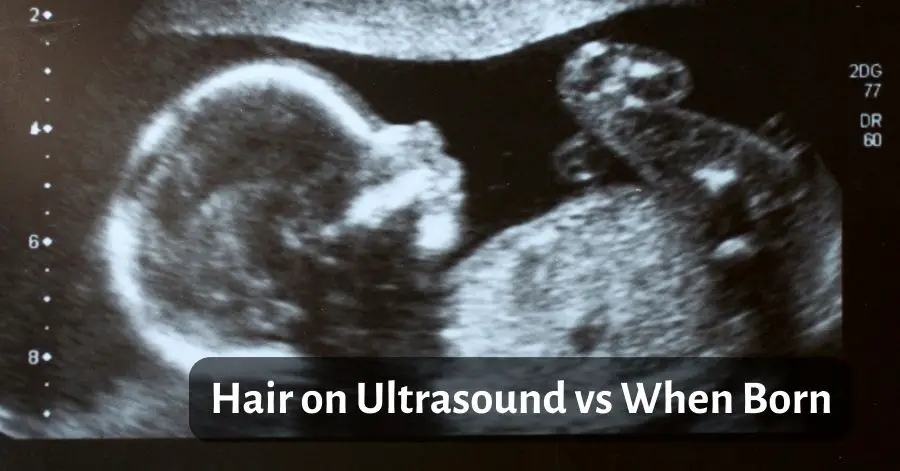Ultrasounds are those sneak peek moments to see exactly who is poking and prodding you from the inside. Your ultrasound technician may point out finer details like hair. But if your baby is showing loads on the ultrasound don’t panic you aren’t growing the next Chewbacca hence why we are going to look further into the amount of hair on ultrasound vs when born.

Hair on Ultrasound vs When Born – Is There A Difference?
The hair seen on a baby’s ultrasound may not be the same as the baby’s hair when born, as temporary hair and genetics can cause differences.
Hair of a baby in ultrasound vs when it is born might not be the same as they look. What’s the real answer between seeing baby hair on ultrasound vs when born?
Lanugo is temporary hair that your baby loses during birth. On ultrasound, these hairs can be mistaken for head hair which is why many babies are born with less than expected. On the other hand, babies who appear bald can actually have volumes of hair.
How To Tell if Baby Has Hair On Ultrasound
After being pregnant several times I can identify with those exciting times when you are given a date to take a sneak peek at your growing bub. You have the same feelings as a child at Christmas. Nerves, butterflies there is nothing that truly prepares you for what you are graced with on the screen.
Types of Ultrasound
As technology expands so does the maternity equipment used during a woman’s pregnancy. Typically the hospital use what is called a 2D ultrasound but many moms choose 3D and even 4D scans.
Which scan gives you as the mom a clearer picture? Can you actually identify a baby’s hair on ultrasound?
2D Ultrasound
According to Very Well Family a 2D ultrasound is the most common method to detect the health of a growing baby. They use sound waves that bounce off every part of your baby and together they give you a picture of who is dancing inside your tummy.
During a late ultrasound around 28 weeks, my doctor wanted to keep an eye on my first baby’s growth, (Lord knows I was humongous!) Needless to say, having a scan this late into my pregnancy was totally different from the 12 and 20 week. My baby was too big to see her full body on the screen but it meant that we had close ups of her little features!
Around her profile, I noticed white fuss, not really paying much attention to it the sonographer proceeded to point out the white fuzz was my daughter’s hair! With tears stinging my eyes I couldn’t actually believe what I was seeing. That night I fell asleep dreaming about cute hair bands and styles I needed to practice.
Fast forward to the birth and as true as it was on my ultrasound my daughter was born with a head full of lovely dark hair.
There are times when seeing hair on an ultrasound can be misleading and in fact, they can come out with less than you anticipated.
Before we jump on to the reasons behind this let’s look at other types of scans.
3D Ultrasound
3D Ultrasounds are completed in a similar way to 2D however it takes pictures at a much faster rate meaning that you get a 3 dimensional image of your baby. Depending on how far you are in your pregnancy will determine how good the scan result is.
If your baby is camera shy then getting a facial picture could be a pain! Let’s be honest, the most exciting part is having that first glimpse of whose nose they have.
In my second pregnancy, I opted for a 3D scan. I was around 19 weeks and during my scan, I was in awe of what we could see! Hiding away was my second daughter. She looked small yet perfectly developed like a tiny doll. The one thing I was excited to ask was about her hair. I couldn’t see a single strand! Yet hair on 3d ultrasound is totally different from a 2D scan. They don’t pick up the presence of hair strands but they can signal areas on the head that suggest hair growth from the scalp.
4D Ultrasound
The 4D Ultrasound takes us to a real live stream of our baby. The outcome can be fantastic as you could get to see their first smile or a yawn. Many parents enjoy seeing the first home of their little one even though it is not a medical necessity.
The same as the 3D scans you aren’t typically going to see your baby with blow-dried hairdo.
Be prepared 3D and 4D scans are not usually covered by insurance so as long as you don’t mind paying for the service you are better off going in the middle of your pregnancy for the best result.
Hair on Ultrasound vs When Born: Expecting Locks
So we have discovered that hair can be spotted on an ultrasound but why are some baby’s still bald when they are born?
In all fairness, I was expecting lushes locks on my first daughter seeing the fuzz on her scans it really was quite a bit. When she was born she did have a fair amount but nothing compared to what I was expecting!
When you spot hair on your scan it could be the temporary hairs that your baby has whilst in the womb. Known as Lanugo, these soft hairs cover a baby to help protect their skin in the amniotic fluid, many babies still have it when they are born.
It can grow all over your little one but is prone to appear thicker on the head, ears and back which is why it can get mistaken for scalp hair.
Alternatively not seeing any hair on your scan doesn’t mean your baby will be born bald either. Think of what happens when you go swimming. Your hair slicks back and sits closer to your scalp, well your little one is having a nine month long spa treatment so the amniotic fluid can have the same effect!
- Hair Loss Before Birth
Your baby is truly a miracle. The amount of work he or she is doing every second whilst in the womb is just mind blowing. This takes us to the fact that babies shed their hair before birth!
Typically your baby will develop their hair follicles at around 14 weeks into your pregnancy but it may take a while for their hair that you may soon be braiding or styling will grow for good.
As mentioned, your baby will grow the first crop of hair called Lanugo. But it is common for this to fall out during your last trimester. This is your baby’s way of preparing for their entry to the world. There is no need for them to keep producing these hairs and as they lose them they will be broken down by the amniotic fluid.
Once your baby is born the hair present on their head will fall out but don’t panic this is totally normal. Both my girls were born with great heads of hair but in the quick weeks that followed they lost the entire lot! I mean totally bald!
My now five-year-old has gorgeous blonde locks and my 8-month-old has just started with her regrowth.
Can You Predict a Head of Hair or Not?
There is no reason why some babies are born bald whilst others could book into the salon on their birthday. The only factor we can rely on is of course genetics.
Your baby is made up of 50% you and 50% of your partner so the genes that are passed through to your baby will detail exactly how much hair they could be born with.
Some people love living their pregnancy according to old wives’ tales too!
Whether it’s guessing the gender of your bouncing bump or discussing how much hair they will have there are many tales that have been passed down through the generations.
Old Wives Tales

The biggest old wives tale you will come across with regard to hair whilst pregnant is,
“Heartburn means hair”
Whether you enjoy following old wives’ tales or not we have to recognize that there could be some scientific truth in this theory.
A study undertaken by Kathleen A Costigan and other scientists has reached a conclusion that the severity of heartburn in expectant moms and the amount of hair on their baby’s head when born has some significance.
Other tales you could follow are typically for gender. If you crave salty foods then it’s likely you’ll have a baby boy and vice versa it’s sweet for a girl. Unfortunately for me ,this fell flat as soon as I hit 2 weeks. I was craving sweets and anything on the dessert menu during pregnancy one and I lived for salty goodness on my second pregnancy. I have two beautiful healthy girls! So it is clear that many old wives’ tales are not scientifically correct.
Factors Affecting Hair Growth in the Womb
Several factors can impact your baby’s hair growth while they’re still in the womb. These factors can include genetics, hormones, and nutrition. For example, a balanced diet rich in vitamins and minerals is essential for supporting healthy hair growth.
A study published in Nutrients found that maternal nutrition can influence fetal hair growth, especially micronutrients like biotin, folic acid, and zinc. Moreover, a deficiency in certain nutrients can lead to slower hair growth or even hair loss. It’s essential to follow your doctor’s recommendations for prenatal vitamins and maintain a healthy diet during pregnancy to promote your baby’s hair growth.
The Role of Genetics in Newborn Hair Growth
As mentioned earlier, genetics play a significant role in determining the amount and type of hair a newborn will have. Your baby inherits genes from both you and your partner, which can influence their hair color, texture, and growth patterns.
Some babies may be born with a full head of hair, while others may have little to no hair. A study in the Journal of Medical Genetics found that genes involved in hair follicle development and hair shaft structure are key factors in determining hair growth and characteristics.
While there’s no way to predict exactly what your baby’s hair will look like, understanding the role of genetics can help you better appreciate the unique traits your baby inherits from you and your partner.
How Can I Encourage Hair Growth Before My Baby is Born?

If the hair your baby is born with is something you wish to promote then research advises that pregnant moms should ensure their diet is rich in omega 3 and fish oils. Not only will this vitamin help boost brain development and stimulate hand-eye coordination but there are some indicators that it can enhance hair growth.
Foods rich in these nutrients are as follows:
- Eggs
- Nuts
- Seeds
- Lamb
- Beef
- Salmon
- Cod
- Tuna
Whilst oily fish have fantastic benefits you must be sure to monitor your Mercury content as it can have adverse effects if consumed in high proportion.
How to Get a Clear Ultrasound of Your Baby
Let’s be honest every mom wants that perfect image of their baby at a scan appointment. There are so many different tips you could try so we have narrowed down the best.
- Hydration
Drinking plenty of clear fluids can help gain a clearer picture of your growing baby. A week before your scan appointment try to up your intake to ensure a crystal clear view.
Don’t make the mistake I made! On my way to my appointment, I was so concerned about having a full bladder that I chugged two bottles before my appointment. This wasn’t only uncomfortable as being desperate for the loo is not a great look but the sonographer actually said my bladder was too full. I had to empty my bladder a little! You don’t realize how hard it is to wee without emptying your bladder!
- Find Your Zen
If you are calm then your baby will be. Anxiety can affect an unborn baby in many ways so even though you could be excited and nervous it is best you try to find ways to get a handle on those nerves.
- You Want an Active Baby
During your examination, the sonographer will give your baby a health check. Measuring a sleeping baby can be extremely difficult so try and eat a piece of fruit before your appointment. Many people swear by drinking a little soda too as the bubbles can help wake up your baby.
- Notice Movements
Later in your pregnancy, you will be an expert at recognizing your baby’s movements. If possible see if you can get your examination around the times where you feel most movement.
On my second pregnancy, my baby was an active little mite! This actually made it harder for the sonographer to measure her limbs etc but trust me they are trained to deal with busy little bumps!

Hair Care Tips for Newborns
Practicing proper hair care from the start will ensure your baby’s hair remains healthy and strong as they grow.
- Be gentle: Newborn hair is delicate and requires gentle care. Use a soft-bristle baby brush or comb to detangle your baby’s hair and stimulate their scalp.
- Wash sparingly: Avoid over-washing your baby’s hair, as it can strip the natural oils and cause dryness. It’s usually sufficient to wash their hair two to three times a week using a mild baby shampoo.
- Avoid chemicals: Stay away from products with harsh chemicals or fragrances, as they can irritate your baby’s sensitive skin. Opt for natural, hypoallergenic products instead.
- Protect from the sun: Exposure to direct sunlight can damage your baby’s delicate hair and scalp. Use a wide-brimmed hat or sunshade when taking your baby outside.
- Trim as needed: Regular trims can help maintain your baby’s hair health and prevent tangles. Use a pair of baby-safe scissors and be cautious not to cut too close to their scalp.
Wrapping Up
I think it is safe to say the comparison between seeing Hair on Ultrasound vs When Born has no bearing. Some babies may have shed fulls of hair that hasn’t been identified on a scan whereas you may be led to believe they have a great head of locks already.
One thing is certain, your baby can lose this first crop of hair leaving less than desired hair line or they may continue to grow healthy thick hair.
No matter what way you look at this your baby will grow their hair back eventually and you will find your new found hairstylist responsibility quicker than you think!
More to Read:
- Can An Internal Ultrasound Be Wrong and Harm My Baby?
- Why do babies’ lips look big in ultrasound?
- What Happens If You Don’t Eat Enough While Pregnant? – Surprising Facts
- Is My Baby Hungry When I’m Hungry During Pregnancy?
- Is It Bad To Not Take Prenatal Vitamins While Pregnant?
- It Feels Like Baby Is Shaking Inside Me! Is That Normal?
- Why Is My Pregnant Belly Soft When I Lay Down – What You Should Know
- Why Does My Pregnant Belly Look Smaller Some Days?
- Can You Crack Your Back While Pregnant – Is It Safe?
- Pregnant and Scared of Life Changing – Guide to Overcome